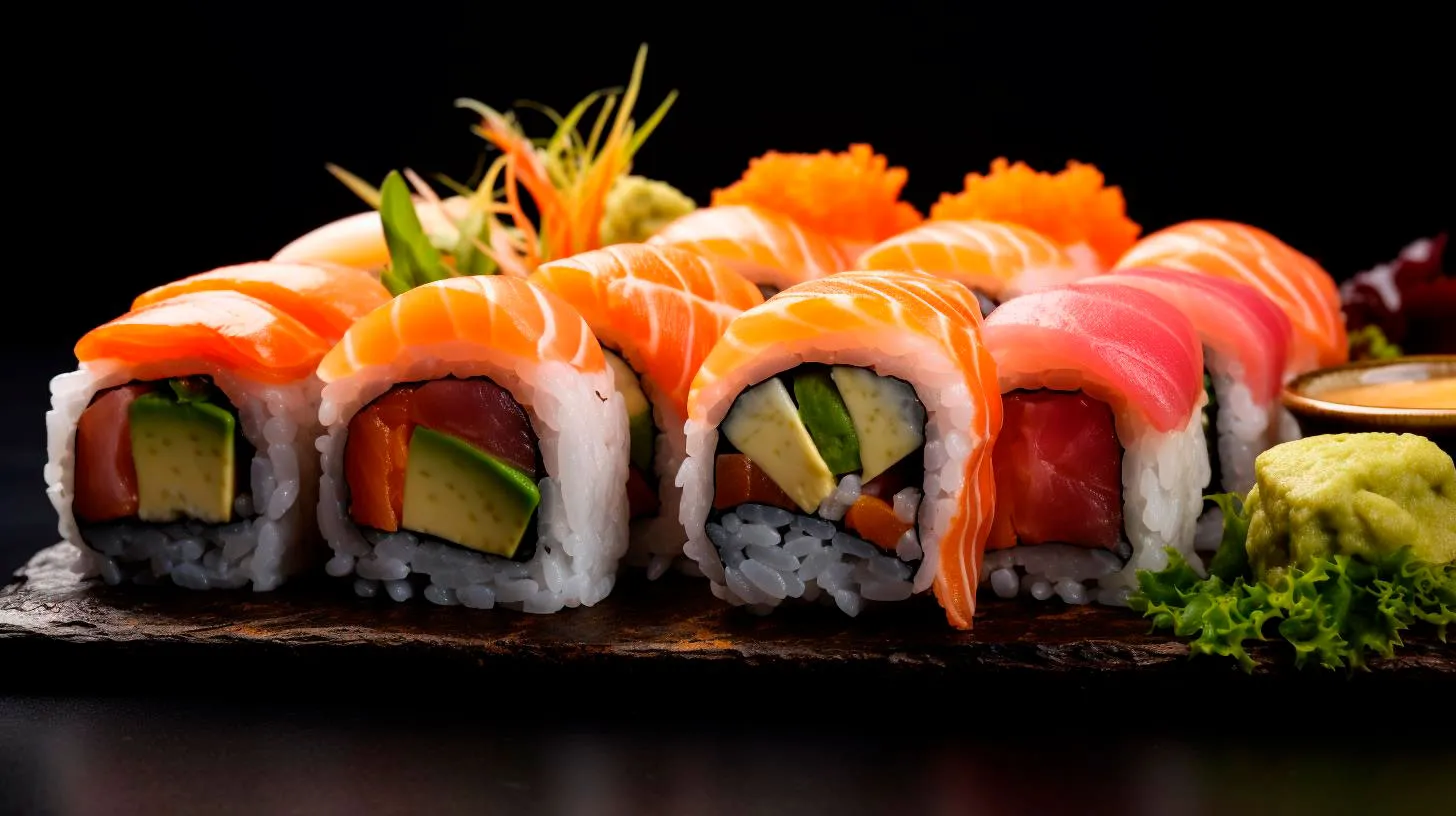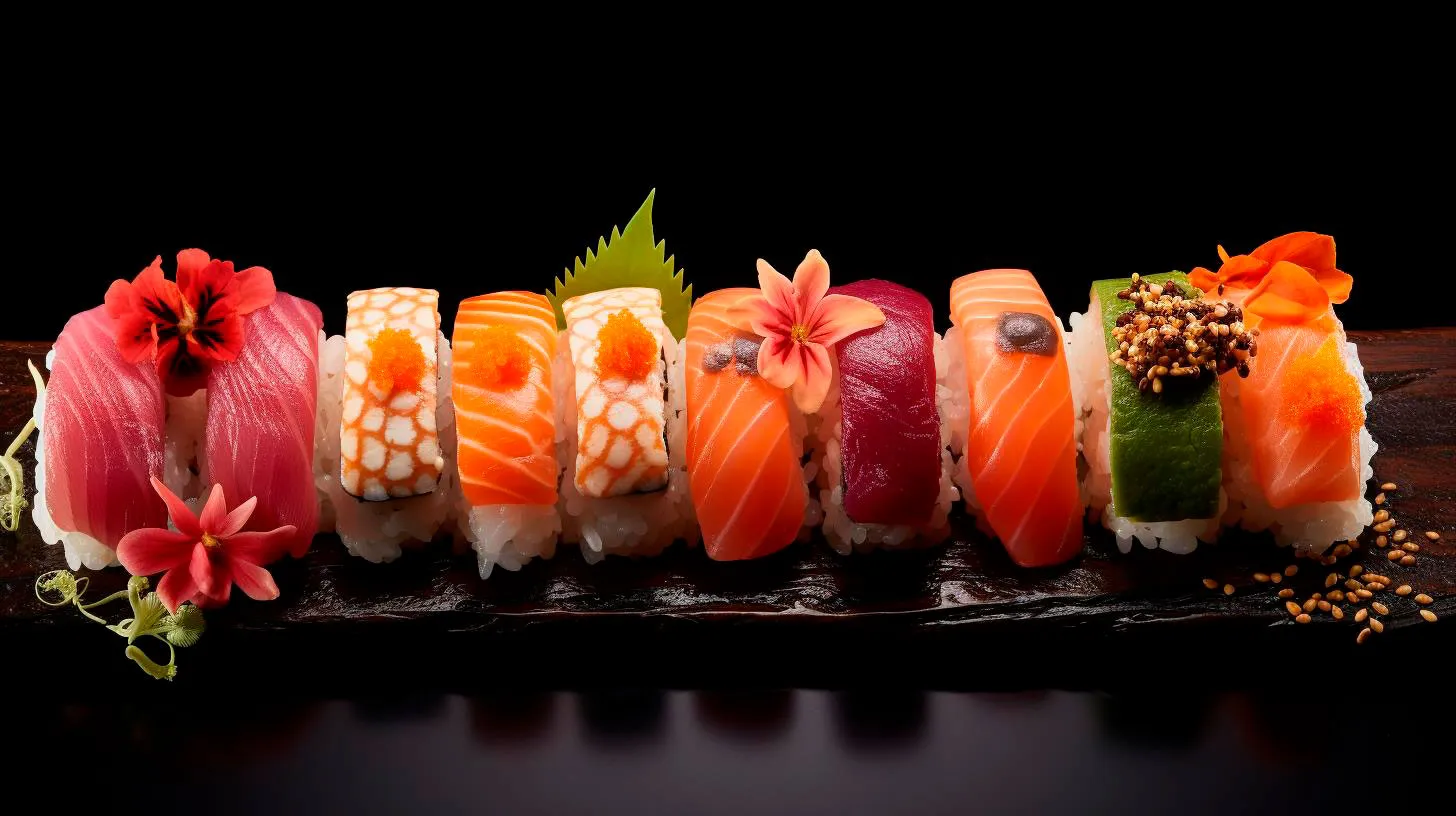From Traditional Techniques to Avant-Garde Creations: Sushi Rice Vinegar Transformed
This tangy and flavorful vinegar has evolved over the years, not only following traditional techniques but also embracing avant-garde creations that elevate sushi experiences to new heights.
The Historical Roots of Sushi Rice Vinegar
Originating in ancient China, sushi rice vinegar made its way to Japan during the Muromachi period (1336-1573). At that time, rice vinegar was used as both a preservative and a flavor enhancer for rice. However, it wasn’t until the Edo period (1603-1868) that sushi as we know it today began to take shape. Sushi masters sought to create a harmonious balance of flavors, and vinegar became a key ingredient in achieving their desired taste.
The traditional method of making sushi rice vinegar involved fermenting rice wine with sake lees (the remnants of sake production), salt, and sugar. This process resulted in a complex and umami-rich vinegar that imparted a unique flavor profile to the sushi rice.
Key Takeaway: The historical roots of sushi rice vinegar can be traced back to ancient China, with its pivotal role in sushi emerging during Japan’s Edo period.
The Transformation of Sushi Rice Vinegar
While traditional sushi rice vinegar still holds a cherished spot in many sushi establishments, modern sushi chefs are embracing avant-garde techniques to push the boundaries of flavor and create unforgettable culinary experiences.
One such technique is using alternative ingredients to ferment the sushi rice vinegar. Chefs are experimenting with fruits like apple or peach to produce unique and fruity notes in the vinegar. This not only adds complexity to the taste but also provides a refreshing twist to traditional sushi dishes.
In addition, the introduction of aged sushi rice vinegar has gained popularity. Similar to the aging of wine or whiskey, this technique involves fermenting the vinegar for an extended period, resulting in a richer and more robust flavor profile. The aged sushi rice vinegar adds depth to the sushi rice, creating a luxurious taste sensation for sushi aficionados.
Key Takeaway: Sushi rice vinegar has transformed through avant-garde techniques, including the use of alternative fermentation ingredients and the introduction of aged vinegar, leading to unique and enhanced flavors.
The Advantages of Modern Sushi Rice Vinegar
Modern sushi rice vinegars offer several advantages over their traditional counterparts, enhancing both the taste and visual appeal of sushi creations:
- Enhanced Flavor: The introduction of alternative fermentation ingredients and aging techniques results in a wider range of flavors, providing chefs with endless possibilities to create unique taste profiles.
- Texture and Appearance: Avant-garde sushi rice vinegars allow sushi chefs to adjust the texture and appearance of the rice. From sticky and fluffy to vibrant hues, these vinegars contribute to the overall visual appeal of sushi rolls.
- Sustainability: Some modern sushi rice vinegars focus on using organic, locally sourced ingredients, promoting sustainability and supporting local farmers.
- Customer Satisfaction: With their innovative and exciting flavor profiles, modern sushi rice vinegars elevate the sushi dining experience, leaving a lasting impression on customers.
Key Takeaway: Modern sushi rice vinegars offer enhanced flavor options, improved texture and appearance, sustainability, and heightened customer satisfaction.
The Rising Popularity of Sushi Rice Vinegar
The global sushi market has experienced significant growth in recent years, reflecting the increasing popularity of this beloved Japanese cuisine. With the demand for high-quality and innovative sushi experiences on the rise, sushi rice vinegar plays a crucial role in meeting these expectations.
In the United States alone, sushi consumption has witnessed an impressive surge, with Americans consuming approximately 4 billion sushi rolls each year. The evolving tastes and preferences of consumers have paved the way for sushi rice vinegar to shine as a fundamental ingredient.
Furthermore, the introduction of fusion sushi, which blends traditional Japanese techniques with flavors from other cuisines, has added a new dimension to sushi rice vinegar. Whether it’s a spicy mayo-infused sushi roll or a tangy kimchi-inspired creation, the versatility of sushi rice vinegar allows for endless experimentation and innovation in the ever-evolving sushi landscape.
Key Takeaway: Sushi rice vinegar’s rising popularity, complemented by the growth of the global sushi market and the introduction of fusion sushi, emphasizes its importance as a key ingredient in modern sushi-making.
In conclusion, sushi rice vinegar has come a long way from its ancient origins, transcending traditional techniques and embracing avant-garde creations. With modern techniques and flavors, it enhances the taste, texture, and visual appeal of sushi dishes, satisfying the evolving palates of sushi enthusiasts worldwide. As the sushi industry continues to innovate, sushi rice vinegar remains a vital ingredient in delivering unforgettable sushi experiences.
Blending Tradition with Contemporary Flavors in Sushi Rice Vinegar
One of the key ingredients in sushi rice is rice vinegar, which adds a tangy and slightly sweet taste. Traditionally, rice vinegar has been used in its pure form, but in recent years, sushi chefs and food enthusiasts have started exploring contemporary flavors in sushi rice vinegar.
The Traditional Role of Rice Vinegar in Sushi
Rice vinegar has been an integral part of Japanese cuisine for centuries. Traditionally, it is made by fermenting rice and allowing it to mature over time. The resulting vinegar is mild, delicate, and provides a subtle tang to sushi rice. It helps to accentuate the umami flavors, balance the sweetness of rice, and act as a natural preservative.
However, with evolving palates and culinary experimentation, sushi chefs are now incorporating new flavors into their dishes. Contemporary sushi rice vinegar varieties are crafted by infusing traditional rice vinegar with a range of ingredients, introducing exciting taste profiles without compromising the essence of traditional sushi.
Exploring Contemporary Flavors in Sushi Rice Vinegar
The emergence of contemporary flavors in sushi rice vinegar has opened up a world of possibilities for sushi lovers. Here are some popular contemporary sushi rice vinegar blends:
1. Wasabi Rice Vinegar:
- A blend of rice vinegar and wasabi
- Offers a subtle spiciness to sushi rice
- Enhances the flavors of raw fish and other sushi ingredients
2. Yuzu Rice Vinegar:
- Combines rice vinegar with the citrusy flavors of yuzu
- Provides a refreshing tang to sushi rice
- Complements seafood and vegetable fillings in sushi rolls
3. Ginger Rice Vinegar:
- Infuses rice vinegar with the zesty and aromatic essence of ginger
- Provides a hint of warmth to sushi rice
- Pairs well with grilled or marinated fish
These contemporary sushi rice vinegar blends offer new dimensions of flavor to traditional sushi, allowing chefs to create unique and exciting taste experiences for their customers.
The Advantages of Blending Tradition with Contemporary Flavors
Blending tradition with contemporary flavors in sushi rice vinegar brings several advantages:
1. Enhanced Dining Experience:
- Contemporary flavors in sushi rice vinegar add a twist to traditional sushi, elevating the dining experience for customers.
- The unique taste combinations create a memorable and enjoyable meal.
2. Versatility and Creativity:
- Chefs can experiment with different flavors, allowing them to create customized sushi rolls and tailored taste experiences.
- Contemporary sushi rice vinegar blends give chefs the freedom to explore their creativity and showcase their skills.
3. Offering Diversity:
- Contemporary flavors in sushi rice vinegar cater to a wide range of palates.
- People with varying taste preferences can find something they love, making sushi more accessible and enjoyable for a larger audience.
In a society where fusion cuisine and innovative flavor combinations are celebrated, blending tradition with contemporary flavors in sushi rice vinegar is a natural progression. It honors the essence of traditional sushi while embracing new taste possibilities.
In Conclusion
Sushi rice vinegar plays a vital role in the overall taste and balance of sushi. Exploring contemporary flavors in sushi rice vinegar adds a modern twist to traditional sushi, enhancing the dining experience and offering a broader range of taste options to sushi enthusiasts. By blending tradition with innovative flavors, sushi chefs can create exciting and memorable sushi rolls that cater to diverse palates. So next time you enjoy sushi, savor the harmonious blend of tradition and contemporary flavors in every bite!
Exploring Modern Innovations in Sushi Rice Vinegar
In recent years, modern innovations in sushi rice vinegar have revolutionized the way sushi is prepared and enjoyed. In this article, we will explore some of these innovations and the impact they have on the world of sushi.
The Role of Rice Vinegar in Sushi
Sushi rice vinegar is a fundamental element in sushi preparation. Traditionally, sushi rice vinegar was made by fermenting rice, giving it a distinct taste and aroma. It was used not only for flavoring the rice but also to prevent the growth of harmful bacteria. As sushi gained popularity globally, the demand for sushi rice vinegar increased, leading to the introduction of modern innovations.
Modern Innovations in Sushi Rice Vinegar
1. Natural and Organic Varieties: With the growing interest in organic and natural products, sushi rice vinegar manufacturers have responded by introducing natural and organic options. These varieties are made using organic ingredients and do not contain any artificial additives or preservatives. This appeals to health-conscious consumers who prioritize clean and sustainable food choices.
2. Reduced Sodium Options: Sodium content in sushi rice vinegar has been a concern for some individuals, especially those with dietary restrictions. To cater to this market, manufacturers have developed reduced sodium variants. These vinegars provide the same great taste while keeping the sodium levels in check, making sushi a healthier option for those watching their salt intake.
3. Infused Flavors: In addition to the traditional rice vinegar flavor, modern innovations have introduced infused varieties. These vinegars are infused with flavors like ginger, wasabi, or citrus, enhancing the overall taste of sushi. The infused flavors add a unique twist to traditional sushi recipes and offer a more adventurous experience for sushi enthusiasts.
4. Ready-to-Use Options: Traditionally, sushi chefs would prepare their own sushi rice vinegar by mixing rice vinegar with salt and sugar. However, modern innovations have led to the introduction of ready-to-use sushi rice vinegar. These pre-mixed vinegars are convenient for home cooks or sushi lovers who want to create restaurant-quality sushi without the hassle of measuring and mixing ingredients.
5. Enhanced Quality Control: With advancements in technology, sushi rice vinegar manufacturers now have improved quality control measures. This ensures consistency in taste, aroma, and quality, allowing sushi chefs to rely on the product for consistent results. Enhanced quality control also minimizes the risk of contamination, making sushi rice vinegar safer for consumption.
Key Takeaways
The innovations in sushi rice vinegar have not only revolutionized the way sushi is prepared but have also enhanced the dining experience for sushi enthusiasts. Key takeaways from these modern innovations include:
- Natural and Organic Varieties provide a cleaner and more sustainable option for health-conscious consumers.
- Reduced Sodium Options allow individuals with dietary restrictions to enjoy sushi without compromising their health.
- Infused Flavors add a unique twist to traditional sushi recipes, offering a more adventurous experience.
- Ready-to-Use Options make sushi preparation more accessible for home cooks and sushi lovers.
- Enhanced Quality Control ensures consistency and safety in sushi rice vinegar production.
As the sushi industry continues to grow, so will the innovations in sushi rice vinegar. These modern advancements contribute to the overall enjoyment and accessibility of sushi, making it a beloved dish for people of all backgrounds.
So, the next time you indulge in a delicious sushi roll, remember the role that sushi rice vinegar plays in creating that perfect bite! Bon appétit!
The Classic Art of Making Sushi Rice Vinegar
In this article, we will delve into the classic art of making sushi rice vinegar and explore its significance in the world of sushi.
The Importance of Sushi Rice Vinegar
Before we dive into the details of making sushi rice vinegar, let’s discuss why it is so crucial to the sushi-making process. Sushi rice vinegar, also known as “su” within Japanese cuisine, not only enhances the taste of sushi rice but also plays a significant role in its texture. Here are some key reasons why sushi rice vinegar is vital:
- Flavor: Sushi rice vinegar adds a tangy, slightly sweet flavor to the rice, complementing the fish and other ingredients in the sushi roll.
- Stickiness: The vinegar helps the rice to become sticky enough to hold its shape when rolled, ensuring the stability and integrity of the sushi roll.
- Preservation: The acidic properties of sushi rice vinegar help preserve the freshness of sushi rice, preventing the growth of harmful bacteria.
The Art of Making Sushi Rice Vinegar
Creating sushi rice vinegar requires a delicate balance of ingredients and techniques to achieve the perfect flavor and texture. Here’s a step-by-step guide to mastering the art of making sushi rice vinegar:
- Ingredients: To make sushi rice vinegar, you will need the following ingredients:
- 1 cup rice vinegar
- 1/4 cup sugar
- 1 teaspoon salt
- Measurements: Start by measuring the amounts of rice vinegar, sugar, and salt according to the recipe. Precise measurements are vital to achieving the desired flavor profile.
- Heat and Dissolve: In a small saucepan, heat the rice vinegar over low heat. Stir in the sugar and salt continuously until they dissolve completely. Avoid boiling the mixture.
- Cooling and Mixing: Allow the vinegar mixture to cool to room temperature. Once cooled, transfer it to a glass or ceramic container. It’s essential to use non-reactive containers to avoid any unwanted flavors or reactions.
- Incorporation: Slowly pour the sushi rice vinegar over the cooked sushi rice, gently folding and mixing it to ensure even distribution.
By following these steps, you can create a delicious sushi rice vinegar that will elevate your homemade sushi rolls to a whole new level.
Key Takeaways
Sushi rice vinegar is the heart and soul of a perfect sushi roll. Here are some key takeaways about the classic art of making sushi rice vinegar:
- Sushi rice vinegar enhances the flavor and stickiness of sushi rice.
- It plays a crucial role in preserving the freshness and preventing bacterial growth.
- The perfect balance of ingredients and meticulous techniques are required to create sushi rice vinegar.
- Precise measurements and non-reactive containers are essential for achieving desired results.
So, the next time you prepare sushi at home, remember the classic art of making sushi rice vinegar. By paying attention to this vital detail, you can truly replicate the authentic taste and texture of traditional sushi. Happy sushi-making!



